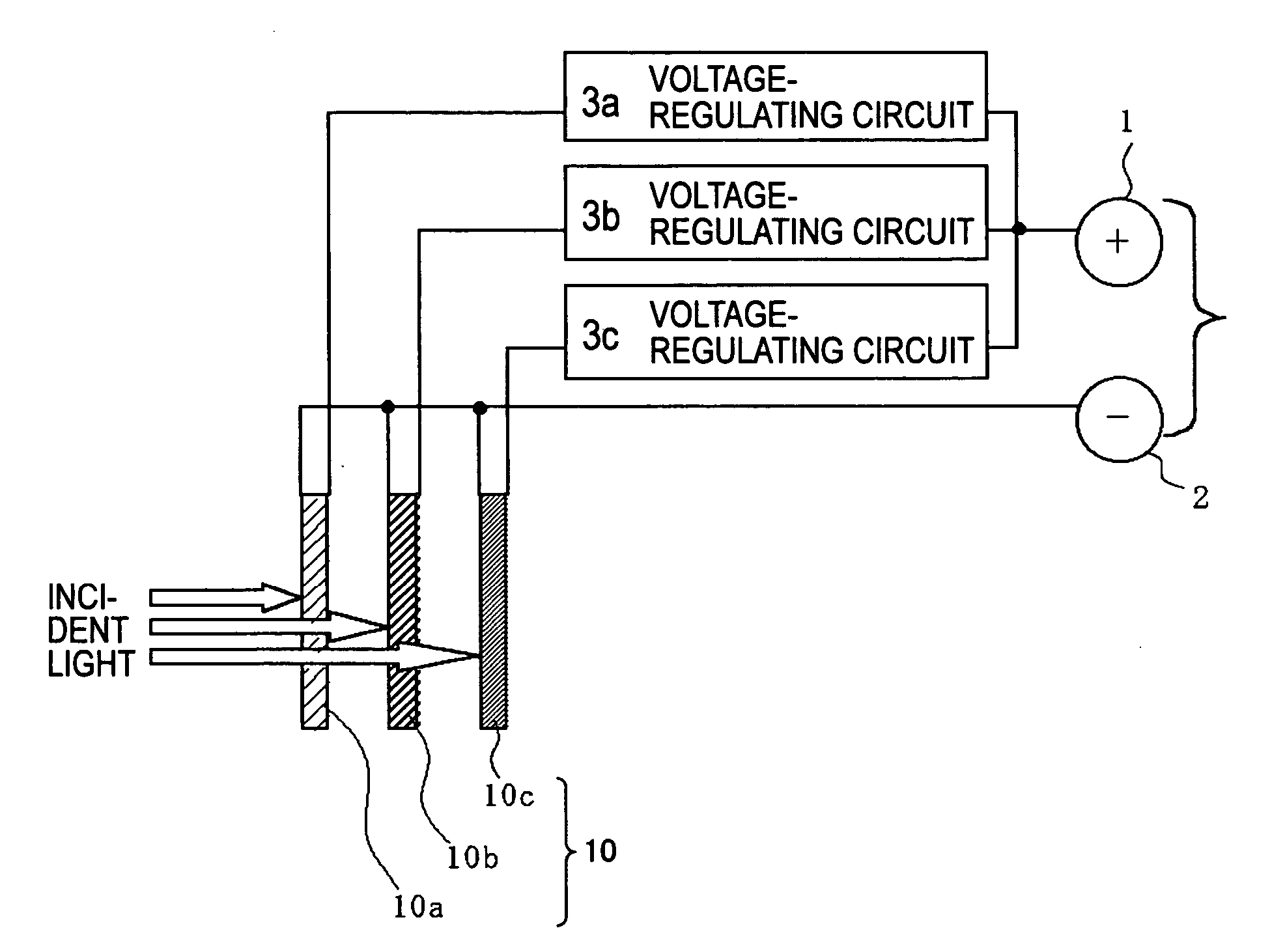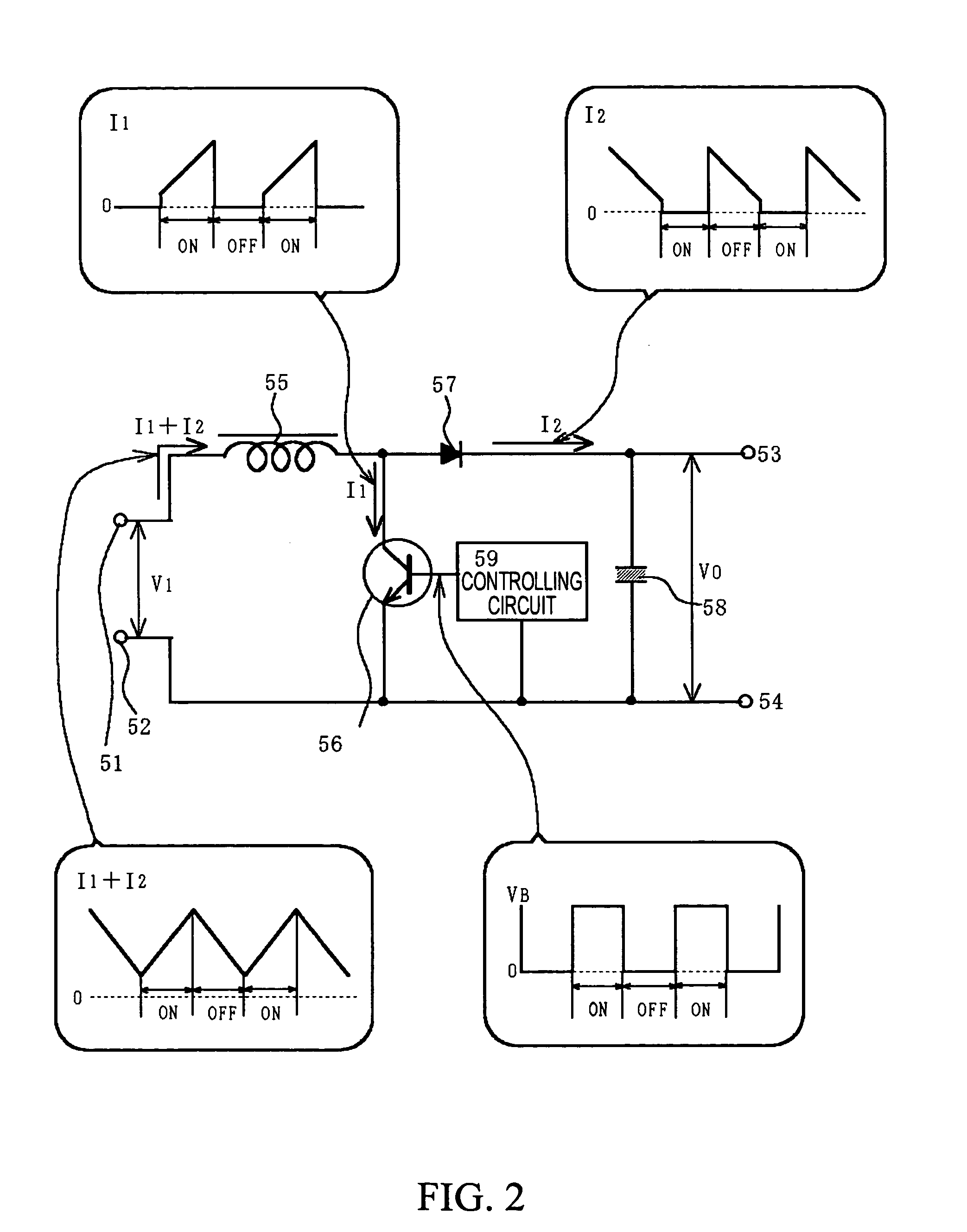Power source device
a power source and power supply technology, applied in the field of power supply units, to achieve the effect of increasing internal resistan
- Summary
- Abstract
- Description
- Claims
- Application Information
AI Technical Summary
Benefits of technology
Problems solved by technology
Method used
Image
Examples
first embodiment
[0050]FIG. 1 is a schematic block diagram illustrating a power supply unit in which outputs of tandem photoelectric transducers 10a to 10c in a tandem wet solar cell 10 are connected in parallel to common output terminals 1 and 2 through voltage-regulating circuits 3a to 3c.
[0051]FIG. 10A is a schematic sectional view of the tandem wet solar cell 10. In the tandem wet solar cell 10, from the position closest to the incident light, the tandem photoelectric transducers 10a, 10b, and 10c are respectively retained in a first layer, a second layer, and a third layer, these layers being formed by a transparent substrate 11, two spacers 20, and another substrate 19.
[0052] The spacers 20 are composed of a transparent material and have a shape allowing light to pass through. The spacers 20 may be, for example, transparent glass plates or transparent plastic plates composed of, e.g., polyethylene terephthalate or polycarbonate. Since the substrate 19 is not required to transmit light, a non...
second embodiment
[0073]FIG. 3 is a schematic block diagram illustrating a power supply unit that stores energies generated by tandem photoelectric transducers 10a, 10b, and 10c, respectively, of a tandem wet solar cell 10 in capacitors 4a, 4b, and 4c as electric charge. The power supply unit then outputs the energies stored in the capacitors by time-sharing as currents at the same voltage across common output terminals 1 and 2 through a voltage-regulating circuit 3d that can connect to the capacitors.
[0074] This output technique using switched capacitors is a modification of the output technique in the first embodiment. Since outputs of the tandem photoelectric transducers 10a to 10c are not simultaneously connected to the common output terminal 1 after the voltages are adjusted, these outputs are not connected to each other in parallel in the strict sense. However, this output technique matches the parallel connection in that all the tandem photoelectric transducers 10a to 10c are substantially co...
third embodiment
[0079]FIG. 4 is a schematic block diagram illustrating a power supply unit according to a third embodiment. The power supply unit includes tandem photoelectric transducers 10a to 10c in respective photoelectric layers, each transducer including many small cells having the same size. The power supply unit produces the same output voltages in all the layers only by setting connections among the small cells in each layer and outputs these voltages in parallel across the common output terminals 1 and 2. This embodiment does not need a voltage-regulating circuit such as a voltage step-up / step-down circuit, unlike the first and second embodiments.
[0080] Double connecting lines in FIG. 4 indicate that the small cells are connected in a matrix by both the series and the parallel connections. In practice, a number of rows, each including a predetermined number of small cells connected in series, are connected to each other in parallel. Hereinafter, the small cells connected in a matrix are ...
PUM
 Login to View More
Login to View More Abstract
Description
Claims
Application Information
 Login to View More
Login to View More - R&D
- Intellectual Property
- Life Sciences
- Materials
- Tech Scout
- Unparalleled Data Quality
- Higher Quality Content
- 60% Fewer Hallucinations
Browse by: Latest US Patents, China's latest patents, Technical Efficacy Thesaurus, Application Domain, Technology Topic, Popular Technical Reports.
© 2025 PatSnap. All rights reserved.Legal|Privacy policy|Modern Slavery Act Transparency Statement|Sitemap|About US| Contact US: help@patsnap.com



